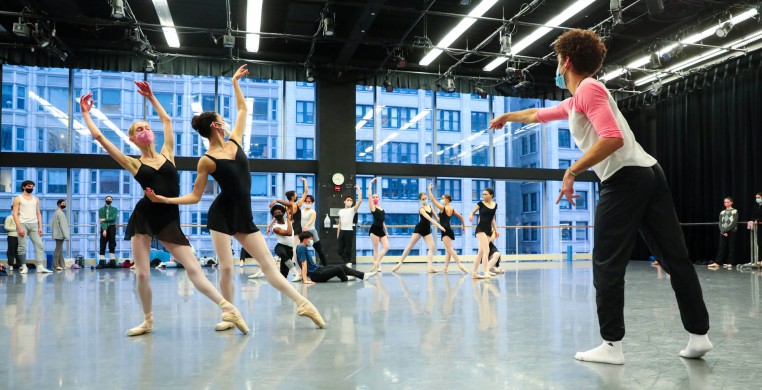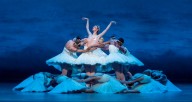The crucial need for diversity and racial equality in the performing arts inspired The Joffrey Ballet to create The Winning Works Choreographic Competition in 2011 to promote talented and emerging ALAANA choreographers (African, Latinx, Asian, Arab, and Native American), whose access to professional exposure has typically been limited in the predominantly white male concert dance industry.
Now in its twelfth season, Winning Works has awarded four fellowships annually to promising and emerging choreographers of color—thirty-seven to date!— many of whom have gone on to illustrious careers. “Winning Works opens doors for them,” said Abbott Academy director at the Joffrey Academy, Raymond Rodriguez in a recent phone conversation with See Chicago Dance.
“A couple have gone on to choreograph for the Joffrey: Chanel DaSilva in 2019, and Chicago’s own Stephanie Martinez in 2020.” Amy Hall Garner, one of the first recipients of the Choreographers of Color award in 2011, was commissioned by the Miami City Ballet and the Paul Taylor Dance Company. Jennifer Archibald, a 2015 recipient, was named Resident Choreographer of the Cincinnati Ballet.
This year, 74 ALAANA choreographers submitted applications. The four recipients of this year’s award represent diverse styles in content as well as cultural backgrounds.
The Joffrey provides each of the recipients a two-week, fully supported rehearsal period in which to develop a new work. Joffrey artistic director Ashley Wheater and Rodriguez provide hands-on mentoring to each of them as they audition the dancers of the Joffrey Studio Company and Trainees, cast their works, and develop and rehearse their material.
All thirty-three dancers are cast, some in multiple pieces. “It’s a well-varied program,” Rodriguez said. Two of the pieces feature female dancers en pointe, one is performed in socks, and one in soft ballet slippers. “There is no “tu-tu ballet,” Rodriguez said, but noted that Joffrey company dance artist Edson Barbosa’s piece is more classically-oriented.
Rodriguez acknowledged that the COVID pandemic has affected the choreographers’ artistic process, but none of the works attempts to use the pandemic as central content. “They were home, alone, and isolated from each other,” he said, describing how the choreographers had to develop their ideas using zoom sessions with dancers they enlisted to help them explore and develop different movement ideas.
“Audrey (Audrey Ipapo Baran), whose family emigrated from the Filipines, wanted to talk about racial inequalities,” Rodriguez said, “especially of Asians. In her ballet, ‘Porcelain,’ she portrays contrasting stereotypes of fragility and sexuality in Asian women.”
Barbosa’s “Life On The Same Boat” is about relationships: “how we fight for each other, how we stand up for each other, how we love each other,” he said during a rehearsal of his piece last fall. Barbosa began studying dancing in his native Rio De Janeiro, Brazil, at the age of ten, and was a trainee at the San Francisco Ballet School. He has been a Joffrey company artist since 2014.
Taylor Carusco’s, “Not Now/But Now,” inspired by MKF Fisher’s science fiction novels, explores the anxiety and stress of his heroine’s time travel, always chasing after the next, but destroying what she leaves behind. During the pandemic, Carusco describes feeling anxious, both chasing after what he wants and running away from it at the same time. The pandemic gave him the time to step back and really question his pre-pandemic lifestyle and priorities.
“The piece is very musically-driven,” Carusco said in a recent phone interview. Three Bach pieces drive the narrative structure. The first movement, set to the Piano Concerto #3 in D Minor, is dark and contemplative. Cello Suite #1, played on the mandolin, signals a mood shift to the playful second movement, a male/female duet. “In this movement, the entire world is lifted,” Carusco explained. The third movement, set to Bach’s Concerto for Two Violins, is vivacious and ends the piece on a high note. But, he says, “it’s an ambiguous ending. Taylor, a dancer with the Cincinnati Ballet, found his most challenging obstacle to be his fear of “the imposter syndrome, and having confidence in what I’ve created. This is the first time others outside my home community will be seeing my work.” Coming from two very different cultural backgrounds—his father is Mexican and his mother’s family from eastern European roots, he found himself “code-switching,” growing up. He wasn’t white and he wasn’t black. “Am I enough for either side of me?” As a queer, bi-racial man, he wanted to give the dancers “the opportunity to feel fully themselves,” which, he says, working with the Joffrey team has given him.
Derrick McKoy’s piece, “Road To Flames,” is set to composer J.R. Stitt’s original electronic and classical music. The concepts of transition, chaos, and creating change inspire him. “Road To Flames” is about passion, heat and fire. Three separate movements each represent a stage of the fire, both destructive and productive. The movement style is contemporary, based on classical ballet line. “It has a lot of ballet in it,” he said. The more romantic “Spark” is “a marriage of piano lines and staccato textures, with a big energy build-up.” “Ember” is a candle flame, softly dancing on its own, shrinking and growing, comprised of five couples in male/female duets, partnering with more classical lines and set to a cello melody. “Wildfire,” comprised of solos, “builds a forest and burns it down. It’s super lightning fast, chaotic and forms the coda of the piece. McCoy uses 20 dancers in all three segments.
Two years ago, COVID-19 quarantine mandates shuttered all live theatre performances across the globe in March of 2020, literally on the eve of final rehearsals in the Elis Neeson Theatre at the Museum of Contemporay Art. Forced to cancel its scheduled performances at MCA, the company made a fast-pivot to virtual performances, reconfigured for the camera and live-streamed from the Joffrey Ballet’s Gerald Arpino black box studio theatre, housed in the company’s home on Randolph Street.
“Winning Works” returns to live performances at The Museum of Contemporary Art March 18-20. (see below for details). The MCA audience capacity of 217 allows for intimacy, but it’s a limited audience, Rodriguez explained. For this reason, the Joffrey decided to film the four pieces and to release them after the live show, reaching an audience of over 20,000.
“Winning Works” has become a win-win opportunity on many different levels, Rodriguez reflected. First and foremost, it fulfills its mission of providing opportunities for choreographers of color. What no one could have predicted was how “Winning Works,” has truly changed the audience demographics for dance and has spurred the inclusion of diverse choreographic voices into the mainstream of western theatrical dance. Not only is “Winning Works” a launching pad for choreographers, it also provides the Joffrey studio company and trainees an essential taste of what it's like to be a professional dancer in the real world as they anticipate launching their performing careers. ”This is real life in a dance company,” Rodriguez said, a win-win on all accounts!
--
The Joffrey Academy of Dance presents "Winning Works" Friday through Sunday at the Museum of Contemporary Art Chicago, 220 E. Chicago Ave.Tickets start at $30 and are available by clicking the event page below.



